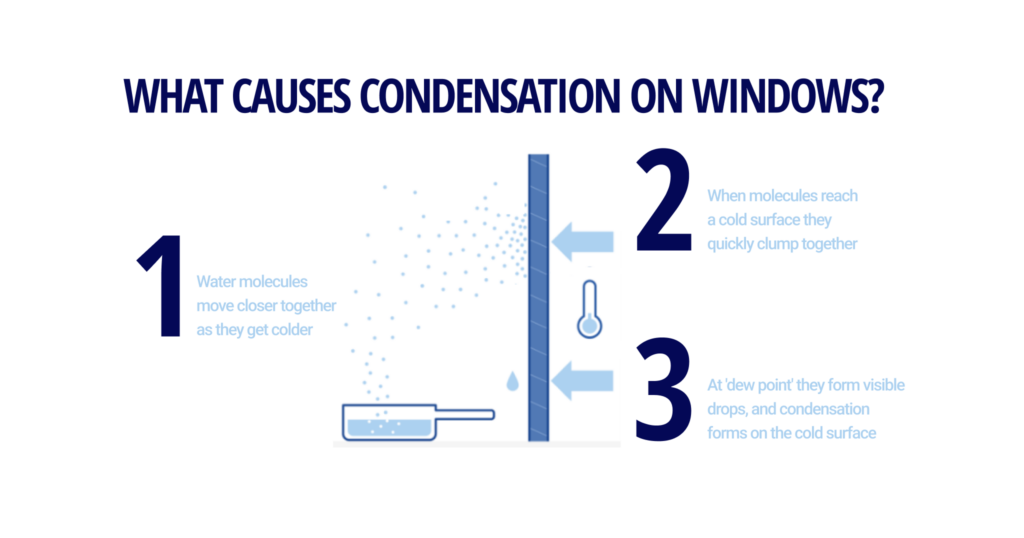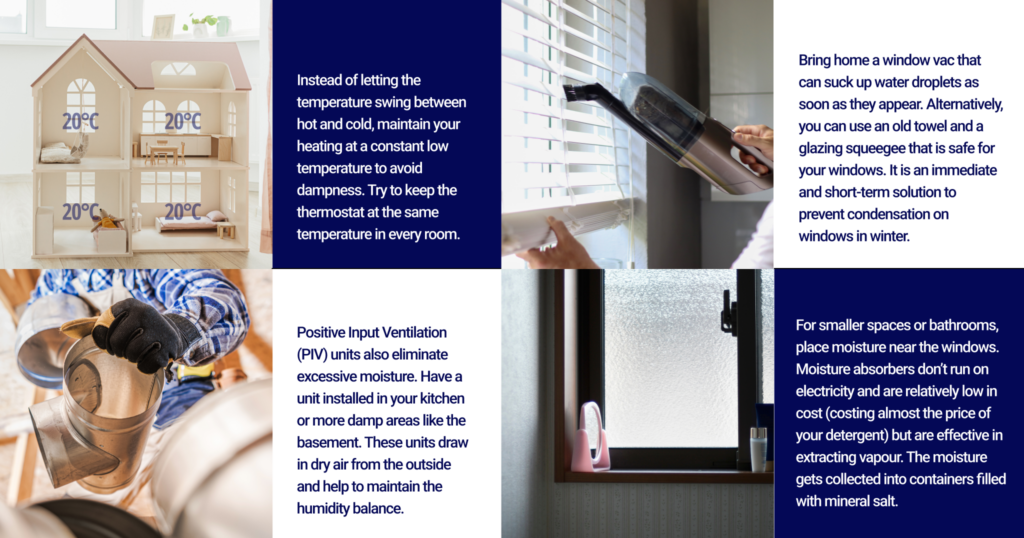It’s not unusual to wake up on cold mornings and find your window panes covered with vapor and tiny droplets. Condensation on windows in winter is a common nuisance that also signals moisture is getting into your home.
The good news? There are solutions. Read on to find out what causes condensation on windows in winter, plus efficient solutions to prevent long-term surface damage.
What Causes Condensation on Windows During Winter
As outdoor temperature drops and the heaters kick in, you’ll see an increase in window condensation. This process occurs the same way condensation forms on the outer surface of a chilled glass of water. The warm, humid air from the surroundings hits the cool glass, leading to condensation.
During winter, the air inside your living space or office is warmer and more humid. The cool air settles down on the outer surfaces of your window panes and comes in contact with the warm temperature through the glass.
Any activity creating excess humidity indoors builds up condensation. The built-up condensation not only disrupts the view but also affects the structural integrity of the windows. Over time, this could mean damage that needs to be repaired. Preventing condensation is the best defense against this.

You may also be interested in: Everything You Want to Know About Smart Film
Common Issues That Increase Condensation on Windows
Condensation on windows in winter is unavoidable during extreme weather conditions. However, some common causes can aggravate this situation.
Inadequate insulation: This is a common problem in old properties with insufficient sealant around the windows. Poor insulation means your windows are targets for condensation. But this doesn’t mean modern constructions with sophisticated insulation systems are not subject to water build-up.
Air conditioning: Condensation isn’t limited to winter months alone. It’s a common occurrence during the summer. Between June and August, the air inside your rooms is comparatively cool. The hot air settles on the outer surface of the windows and gets in contact with the cooler air from the air conditioner leading to condensation. The phenomenon is similar to wintertime but in reverse order when cold air settles on the windows instead of warm air.
Houseplants: If you’re a plant lover, you probably already know that houseplants add moisture to the air. To combat this additional moisture, we recommend investing in indoor plants that help lower indoor humidity. Humidity-absorbing plants like the Boston Fern, Palms and Spider Plant are natural dehumidifiers.
Hot showers: Hot showers and baths are other common culprits for adding heat and humidity during the deep depths of winter. While it’s inevitable for you, it creates a whole steam bath for your windows.
Low-quality glass: The kind of glass you choose for your windows matters when it comes to condensation. An effective way to deal with it is to add glazing to your glass for added insulation.
Partnering with a knowledgeable glass consultant can help determine what kind of glass you need to navigate structural changes and prevent long-term damage.
Major Issues Due to Condensation on Windows in Winter
From compromising the air quality to dealing with water leakages, there could be several unexpected problems in the long haul if condensation builds up year after year.
Structural damage: As condensation settles on your windows and surrounding panes and structure, it’s not getting ventilated away. Since it has nowhere to go, the excess water drips down into the frame of your window, rugs and carpets.
The built-up water causes damage over time, which could lead to costly replacements and renovations.

Mold or Mildew: Mold or mildew are common concerns when excess moisture traps on the internal surface of your window frames. This problem can amplify over time and affect air quality and your health..
This is especially important for people with sensitive lungs, allergies or respiratory issues.
According to the Mayo Clinic, some common symptoms of mold allergies include:
- Stuffy or running nose
- Sneezing or wheezing
- Cough and postnasal drip
- Red or itchy eyes
- Skin rashes and itching
3 Effective Ways to Prevent Condensation on Windows
We’ve listed the three most effective ways to deal with condensation on windows in winter below.
#1. Improve ventilation
You sure need the heater up and running most of the time in winter but opening your windows from time to time to let in fresh air goes a long way to prevent condensation.
Check if your windows have trickle vents. These are small components within a window. You may briefly open the trickle vent slightly after a hot shower or while cooking. This will let the warm air disappear and avoid condensation.
Additionally, you can also get an extractor fan installed if you don’t already have one. If you do, make sure to clean it and renew the filter so it can work at the best efficiency.
The same logic applies to your curtains and blinds. Open the curtains and blinds in the morning to keep fabrics dry and potentially safe from dampness. It will encourage air circulation and let natural light seep through while preventing moisture from getting trapped in the room.
#2 Use dehumidifiers
During winter, the moisture in the air makes the space cooler. Dehumidifiers help reduce the cost of heating by drawing away moisture. They’re an inexpensive way to treat your home for condensation buildup.
For smaller spaces, a compact dehumidifier could be the most cost-effective option, especially if your windows don’t have a trickle vent to let in fresh air. Dehumidifiers draw moisture from your room. The vapor, microbes and other particles get collected in the dehumidifier container as waste water.
While a compact dehumidifier can work for smaller spaces, on the flip side, you might need to empty the container more often than the bigger counterparts.

Common Ways to Reduce Condensation on Windows in Winter
These DIY, budget-friendly options are good as short-term solutions to prevent condensation on windows in winter. But if the problem persists, it’s best to get a free estimate from a reliable professional.
3 Get an upgrade
The best long-term solution to prevent condensation on windows in the wintertime is to upgrade with high-quality glass. Tri-Pane, Low-E glass and glazing with superior thermal performance ensure rooms are better insulated and the interior of your home is protected from damage and mold.
Fresh glass installation also helps regulate temperature fluctuations between seasons. Our insulated glass or double-glazing solutions (against the single-glazed glass) provide added benefits to help keep moisture at bay.
If you have additional questions or need help tackling condensation on your windows in winter, we’re here to help. Our experienced team of professionals can help you upgrade your windows and recommend the best glass to deal with condensation on your windows.


